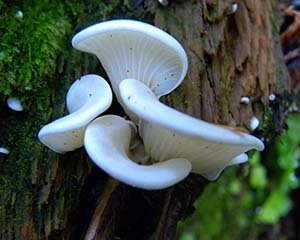Oyster mushroom Nutrition facts
Oyster mushrooms are large, oyster-shell-shaped edible fungi species. Their chewy, flavorful, fruiting bodies are widely popular in Chinese, Japanese, and Korean cuisine. It is native to the dense forests of North America, Northern Europe, and Siberian Asia.
Botanically, they belong to the family: Pleurotaceae, and the genus: Pleurotus.Scientific name: P. ostreatus. They are also known by names as abalone mushroom, pearl oyster mushroom, hiratake, Xiùzhēn gū (秀珍菇), etc.
 |
| Oyster mushrooms. Courtesy: Peter Stevens. |
Apart from the common oyster, some of the highly valued, edible Pleurotus species that are grown for their delicate fruiting bodies are:
P. eryngii (king oyster mushroom)-is the largest species among Pleurotus family mushrooms and has a rich flavor. Its club-shaped, thick stalk is firmly attached to the cap.
P. pulmonarius is also known as phoenix or Indian oyster mushroom. It is smaller and paler than pearl oyster mushrooms and prefers warm weather.
P. populinus is native to North America and fruits in the summer months.
P. djamor (The pink oyster mushroom) grows in tropical warm regions.
P. australis (brown oyster mushroom) has large brown caps and is commonly found in Australian and New Zealand forests.
P. cystidiosus (abalone mushroom or akuratake).
Identification
Oyster mushrooms can be easily identified by their grey-white, oyster-shell-shaped cap which is attached to a thick, firm stalk (stem). Their undersurface is featured by highly defined gills that run right from the edge of the cap up to the middle of the stalk. The cap measures about 5-15 cm in diameter. The stem is 2-4 inches in length.
Cultivation
Oyster mushroom is unique in being the only edible saprophytic fungus that preys on certain nematodes and insects from which it gets nitrogen to flourish. In their natural habitat, Pleurotus species grow on dead and decaying logs and living tree trunks of coniferous and beech trees.
Oyster mushroom cultivation under supervised farms has revolutionized its continuous supply to the ever-increasing consumer demands. Any kind of sawdust and agricultural waste that is rich in lignin and cellulose can become a suitable substrate for its cultivation. Fruit bodies appear about 25 days after spawn inoculation.
Health benefits of Oyster mushrooms
P. ostreatus is one of the very low-calorie mushrooms. 100 grams of fresh fungus carries just 33 calories. Nonetheless, these flavorful fungi are loaded with natural bioactive compounds, antioxidants, minerals, and vitamins that promote health.
Oyster mushroom contains a HMG-CoA reductase enzyme inhibitor substance called statin (lovastatin or Mevinolin-2.8% dry weight).
They compose β-glucan which has anti-viral and anti-allergic properties.
Certain protein polysaccharides in the oyster mushroom have been found to have anti-hyperglycemic, anti-soft tissue tumor, immunomodulatory, anti-inflammatory, and antihypertensive effects in experimental animal studies.
In the traditional Chinese medicine (TCM), the oyster fungus is known to dispel cold wind, relax tendons and bones, and strengthen yang. It is indicated to treat impotence, weakness of joints and limbs, and backache problems.
Oyster mushrooms carry relatively higher amounts of good quality protein than other cultivated mushrooms.
Fresh mushroom is an excellent source of folic acid (38 μg 9.5% per 100 g).
Further, they contain ample concentrations of other B-complex group of vitamins like thiamin, riboflavin, niacin, pantothenic acid, pyridoxine, etc.
Minerals such as copper, iron, and phosphorus present in moderate levels in this mushroom.
Oyster mushrooms are modest sources of vitamin D (ergo-calciferol) at 29 μg per 100 g (7% of DA). Vitamin D plays a vital role in calcium and phosphate metabolism.
| Principle | Nutrient Value | Percent of RDA |
|---|---|---|
| Energy | 33 Kcal | 1.6% |
| Carbohydrates | 6.09 g | 4.7% |
| Protein | 3.31 g | 6% |
| Total Fat | 0.41 g | 2% |
| Dietary Fiber | 2.3 g | 6% |
| Vitamins | ||
| Folates | 38 μg | 9.5% |
| Niacin | 4.956 mg | 31% |
| Pantothenic acid | 1.294 mg | 26% |
| Pyridoxine (B-6) | 0.110 mg | 8% |
| Riboflavin | 0.349 mg | 27% |
| Thiamin | 0.125 mg | 10% |
| Vitamin-D | 29 IU mg | 7% |
| Electrolytes | ||
| Sodium | 18 mg | 1% |
| Potassium | 420 mg | 9% |
| Minerals | ||
| Calcium | 3 mg | <1% |
| Copper | 0.244 mg | 27% |
| Iron | 1.33 mg | 16.5% |
| Magnesium | 18 mg | 4.5% |
| Manganese | 0.113 mg | 5% |
| Phosphorus | 120 mg | 17% |
| Selenium | 2.6 μg | 5% |
| Zinc | 0.77 mg | 7% |
Selection and storage
Fresh and dried oyster mushrooms can be readily available in US supermarkets. Choose non-slimy and evenly colored oyster mushrooms with a smooth cap and no black spots. Pleurotus mushrooms are highly perishable and absorb the flavor of surrounding foods. Consume them immediately.
They also sold dried and in brine in these stores.
For storage, place them in a paper bag or in a dish covered with cloth for a short period (2-3 days). Dried oysters in sealed packs and vacuum packs can stay well for many months.
Preparation and serving methods
Fresh oyster mushrooms do not require washing. Just clean any surface dirt or sand particles using a soft brush. You can tear the ears (caps) by hand since they cook evenly in the dishes because of the uniform thickness of the caps.
Oyster mushrooms impart mild mushroomy flavor and distinct fleshy texture in the dishes. Thus, they can be an ideal substitute in the dishes that call for pork or poultry. Do not mask their flavor by pairing them with strongly flavored foods or cooking them in a large amount of butter or oil. They can be sautéed or boiled for 3-5 min, quickly braised, or baked for 7-10 min. Their stems require a longer cooking time and benefit from being chopped evenly.
 |
| Oyster mushroom and goat cheese ravioli Pan Pacific |
Here are some serving tips:
In mainland China, oyster mushrooms are usually stir-fried with complementing vegetables as a side dish.
They are also delicious braised, sauteed, marinated, or grilled.
They can be simply enjoyed sauteed in garlic oil or butter.
They are added to soups and sauces and work well with rice, pasta dishes, eggs, tofu, poultry, and seafood.
Fine sliced oyster mushroom can also be added in pizza, pasta, and potpie preparations.
Safety profile
Eating cooked oyster mushrooms rarely causes any hypersensitivity reactions. Sniffing raw, large, spore-bearing oyster caps, and in persons who work indoors engaged in mushroom cultivation may develop serious allergic alveolitis and mushroom workers' lung disease. Workers in the farms are advised to wear masks to limit spore inhalation. (Medical disclaimer).
≻≻-Back to Mushrooms from Oyster mushroom. Visit here for an impressive list of edible mushrooms with complete illustrations of their nutrition facts and health benefits.
≻≻-Back to Home page.
Further reading and Resources: